
Are your chickens happy in their wooden coop? Is your chickens’ coop strong enough to make it through another winter? Is it time you upgraded your wooden coop? These are all questions many chicken keepers ask themselves when facing the reality that their wooden coop may not do its job, especially for another cold season. Take this short quiz to see whether your wooden coop is ready for this round of wintery weather.
Wood absorbs water – does your coop seem heavier?
A = Yes – either I’m getting weaker, or my coop has gotten heavier.
B = Yes, but I solved it by getting someone else to move the coop for me.
C = I’ve given up trying to move it.
D = Nope, I spent the summer sanding and sealing my chicken coop with a varnish, so now it’s more water-resistant.
Have you had to pour boiling water onto locks to get them to open?
A = Yes, I have to keep a coop de-icing kit.
B = Boiling water sounds easier than smashing the bolt with a rock or brick to get the coop unlatched during a freeze.
C = I religiously grease all hinges and bolts every few weeks to keep things moving.
D = I have very carefully aligned my coop to the morning sun so that the bolts and hinges have defrosted by the time I get out. On cloudy days I resort to hot water.
Has your wooden coop shifted or expanded since last winter?
A = Yes – the doors all seem too big for the frames, and nothing opens or shuts properly anymore.
B = Yes – the panels have swollen, and now I’m concerned for when they shrink again because I added extra chickens to fill the void.
C = For the most part it appears fine, but some sections don’t align the way they used to.
D = No – the staining and sealing seems to be keeping the coop intact.
Is the roof leaking?
A = Yes – I’ve already fixed the roof a few times this year, and now it’s already leaking again.
B = Yes, but this is the first time and I’m confident that I can fix it myself.
C = No – there aren’t any obvious leaks.
D = My wooden coop is brand new, so I don’t expect to have any problems this winter.
Is it cold and damp inside?
A = Yes – it feels cold inside, and the bedding gets damp quickly.
B = It’s a little chilly, but my hens huddle together to keep warm.
C = I haven’t noticed any dampness, and my hens act alright.
D = The coop keeps warm overnight once I have shut the door, and my chickens are outside during the day.
Did you have difficulties with red mites in summer?
A = Yes – I’ve had to prevent and treat red mites in my coop and chickens regularly, and I’m already dreading the next resurgence.
B = No more than usual – it’s just part of chicken keeping, and I’m used to dealing with them.
C = I had mild issues with red mites, but they weren’t out of control.
D = The red mites didn’t cause a problem in my coop this year.
How long does it take to clean your coop?
A = It’s an all-day task that I dread, so it doesn’t get cleaned regularly in winter.
B = It takes a while, especially in the winter, but I know my hens appreciate it.
C = It takes a few hours, but the whole family helps.
D = It doesn’t take me long at all – I have a good system in place.
The results…
Mostly As = If you experience repeated and frequent issues with your wooden chicken coop like red mites, a leaking roof, or poor ventilation, it’s definitely time to upgrade to a plastic chicken coop. Keeping chickens in the winter doesn’t have to be a dreaded or labor-intensive experience. Plastic chicken coops keep your chickens comfortable, dry, and mite-free all year round.
Mostly Bs = You’ve valiantly kept your wooden chicken coop going this long, and are determined to keep persevering through wooden chicken coop repairs. But the question remains: are your chickens happy in their wooden coop? Keep a watchful eye out for dampness and drafts inside of the coop, as these are extremely dangerous for hens – especially the older members of your flock.
Mostly Cs = You’re no stranger to wooden chicken coops and the potential problems and maintenance they present. But, there are plenty of reasons to avoid wooden chicken coops and to make the switch from wooden to plastic hen houses. Cleaning, comfort, and your overall workload will decrease substantially when you update your coop to plastic.
Mostly Ds = Your wooden chicken coop is in its early days, or you’ve spent countless hours preparing and preserving its integrity. Keep in mind however that all wooden chicken coops rot eventually, and all preservation methods are just that – a temporary improvement until the elements leave their mark on your wooden coop once more. If you’ve just invested in a wooden chicken coop and aren’t ready to make the switch to plastic, consider making some weather-resistant upgrades like an Automatic Chicken Coop Door to keep your hens more comfortable in the cold.
Upgrade with Omlet
Don’t just survive the winter weather – thrive in the cold. With our line of plastic chicken coops, your hens will be warm, dry, and comfortable whatever the weather. The Eglu Cube Chicken Coop is designed for larger flocks to find shelter in the bitter cold. And, with accessories like the Autodoor, you can schedule your flock’s outings to take place during the warmest part of the day, while keeping them tucked in a well-ventilated, draft-free coop at night. See how keeping chickens in the winter doesn’t have to be a chore, just another season to love your flock.
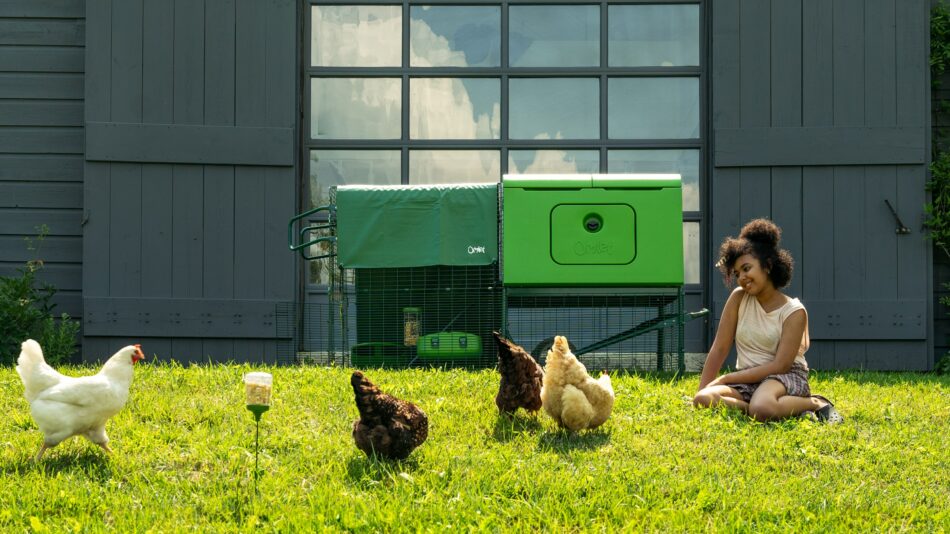
This entry was posted in Chickens on January 28th, 2020 by linnearask
Come and visit us in Boston & Seattle!
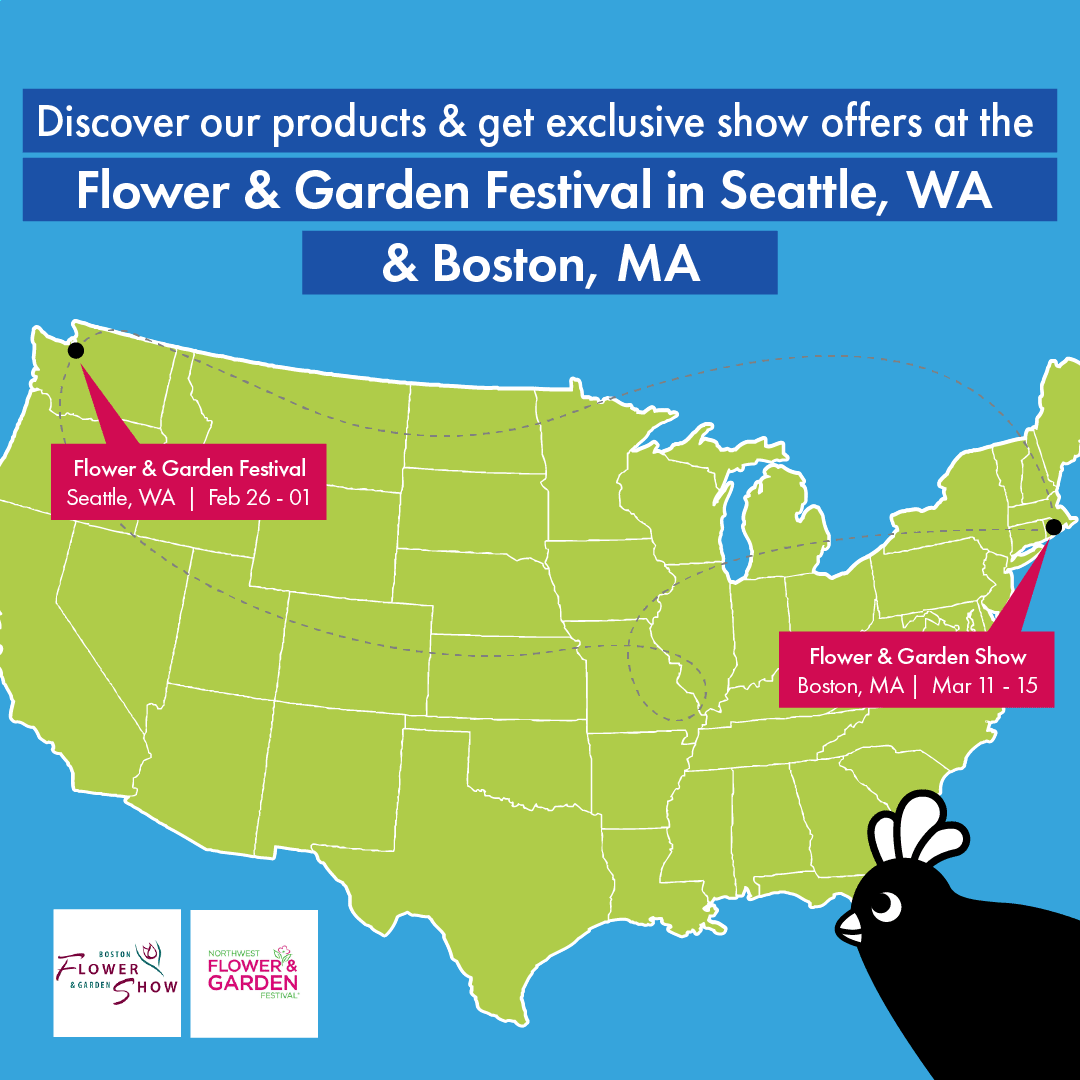
Omlet are delighted to announce that we will be at the Boston, Flower and Garden Show March 11-15 2020 and at the Northwest, Flower and Garden Festival in Seattle, WA February 26 – March 1st 2020.
Come and visit our booths to meet our team of chicken eggsperts, ask questions and discover the following products:
Make sure you asked about our special show offers!
The Boston Flower & Garden Show will close at 6 p.m. today, Friday, March 13, 2020. The scheduled show days of Saturday, March 14 through Sunday, March 15 have been cancelled.
Reasons why you should come and visit us
- Discover our product range in person.
- Compare our chicken coops and see which one is right for you.
- Meet our pet experts and ask them questions.
- Get a full demonstration of the features and benefits of an Omlet product.
- We will be offering show discounts
Useful information:
Boston, Flower and Garden Show
Dates & Hours:
Wednesday, March 11: 10:00AM-7:00PM
Thursday, March 12: 10:00AM-7:00PM
Friday, March 13: 10:00AM-9:00PM
Saturday, March 14: 10:00AM-9:00PM
Sunday, March 15: 10:00AM-6:00PM
Show Location:
The Seaport World Trade Center
200 Seaport Boulevard, Boston, MA 02210
Website:
https://bostonflowershow.com
Booth Location:
Booth number 336 (see map below)
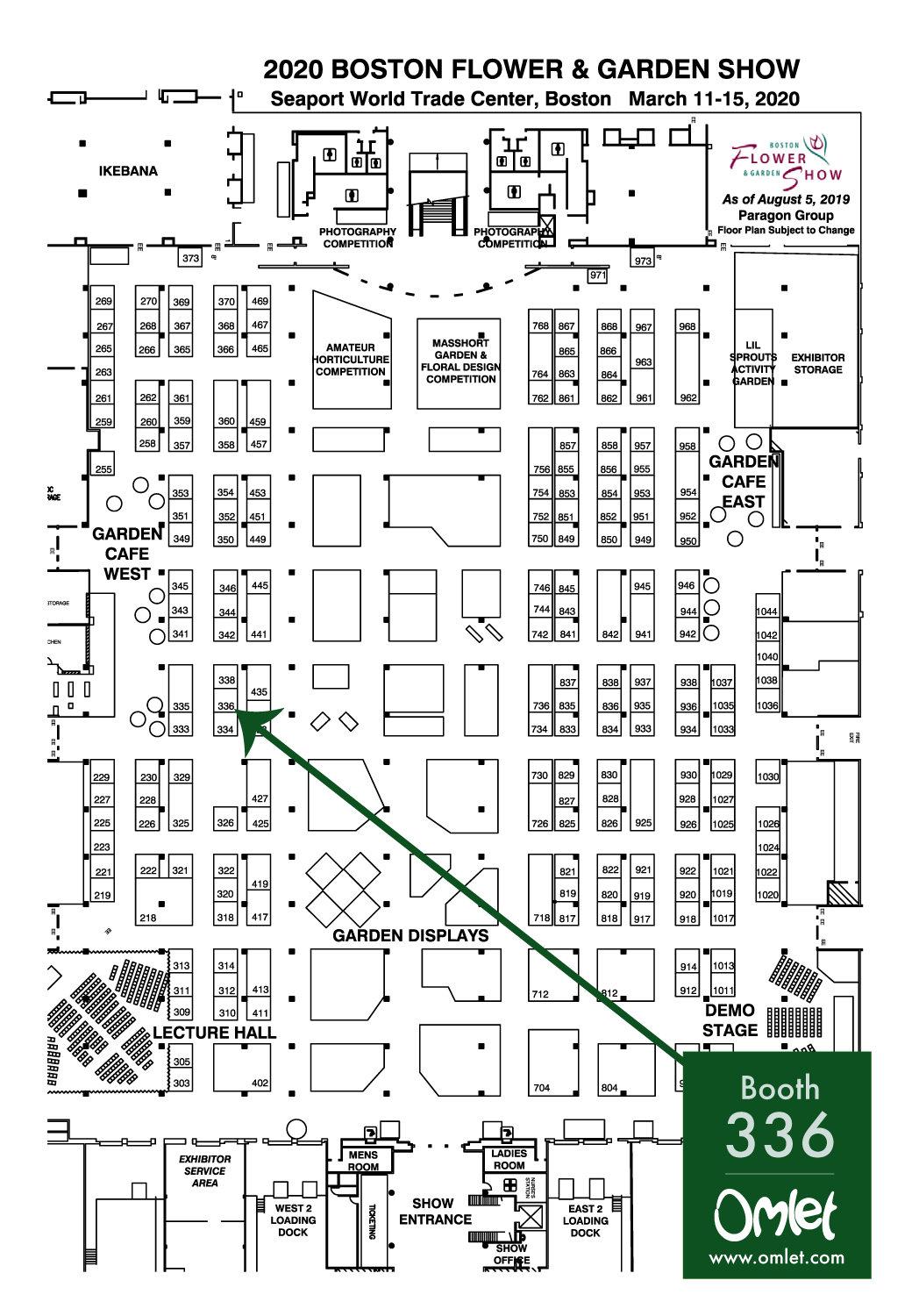
Northwest, Flower and Garden Festival in Seattle, WA
Dates & Hours:
Wednesday, February 26 – Sunday, March 1, 2020
Wednesday – Saturday: 9:00am – 8:00pm
Sunday: 9:00am – 6:00pm
Show Location:
Washington State Convention Center
705 Pike Street – on the corner of 7th and Pike Street Seattle, Washington 98101
Website:
https://www.gardenshow.com/
Booth Location:
Booth number 2212 (see map below)

This entry was posted in Uncategorised on January 27th, 2020 by mathieugrassi
One of the great things about the Omlet Outdoor Cat Run is how extremely versatile it is. The run in itself can be modified to fit the space you’ve got and the need of your cats, but it doesn’t stop there! We constantly see creative and and fun ways of using the run, and we thought we might share some that could inspire you, whether you’re getting a run for the first time, or are just looking for ways to getting the run ready for spring!
DECORATIONS
When it comes to decorating the cat run there are practically no limits. Allow your cats to do all the things like like on the run, whether it is climbing, playing, running, scratching, hiding, or just lounging in a hammock. You can make the run even more practical with run covers that allow you cat enjoy the run in all weathers, or a chair for you to sit on while you’re spending time with your furbabies. We also love all the (catfriendly) flowers and plants that customers add to the run to make it blend in to the garden even more!

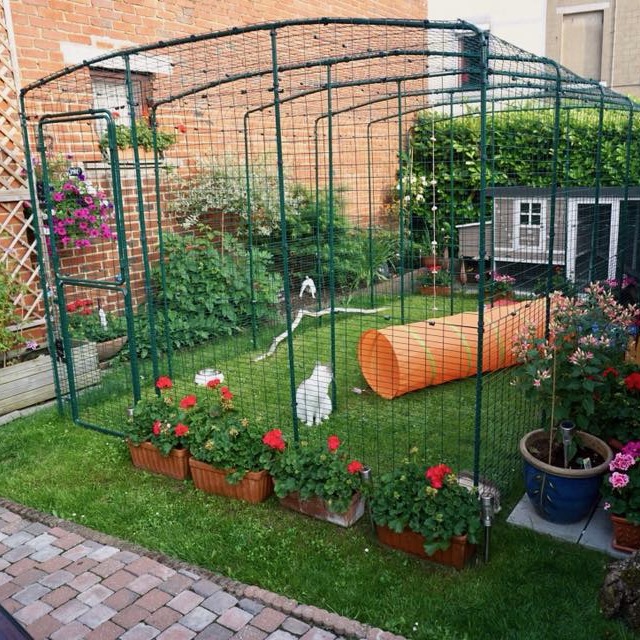


CONNECT IT TO THE HOUSE
The cat run comes with four walls, but is robust enough to be stable with only three of them. If you manage to find a way to secure the open end to the house, this is another way of allowing the cats to move between inside and outside at their own will. This amazing set up is from a customer in Denmark, with a special kitty entrance from the basement into the run in the garden, where by the looks of things both humans and felines will enjoy spending time. By combining clear and heavy duty covers they have also made sure the cats are safe from both rain and sun while out on the run.
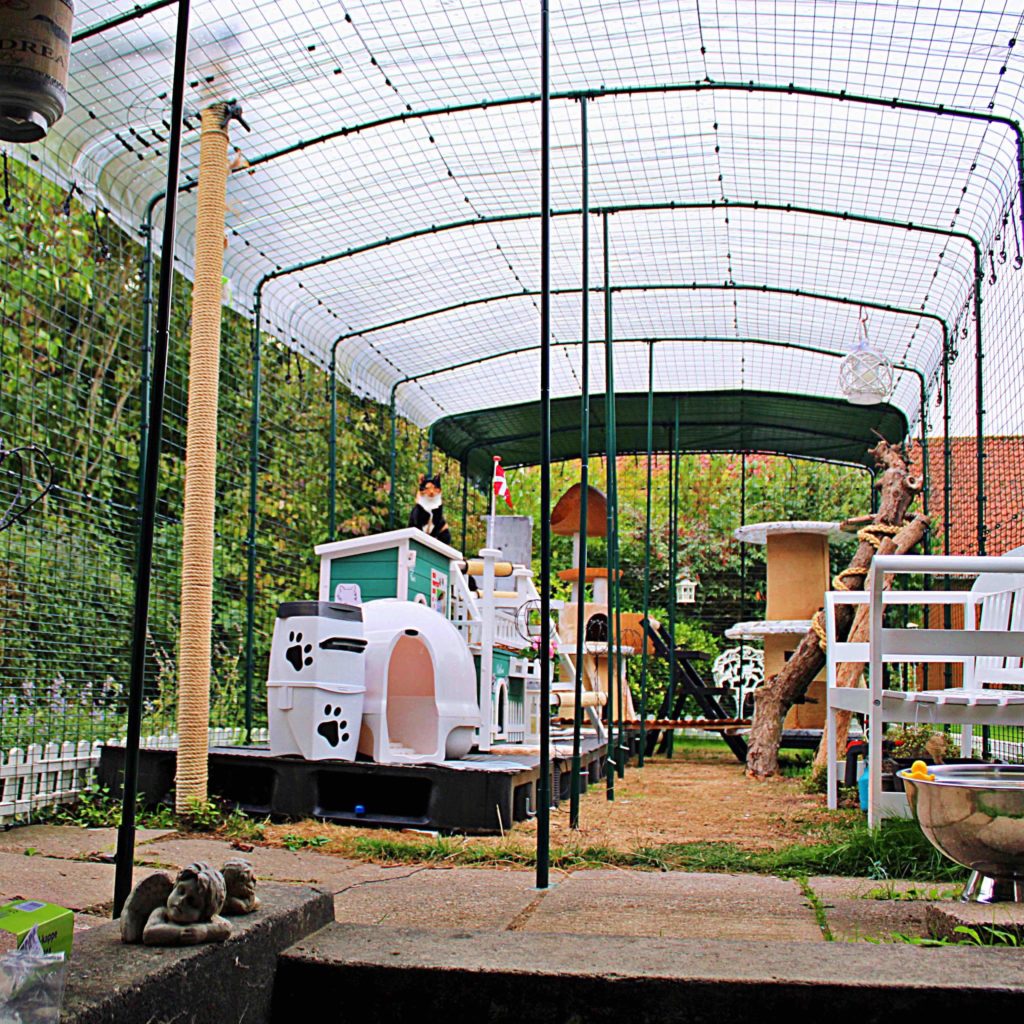
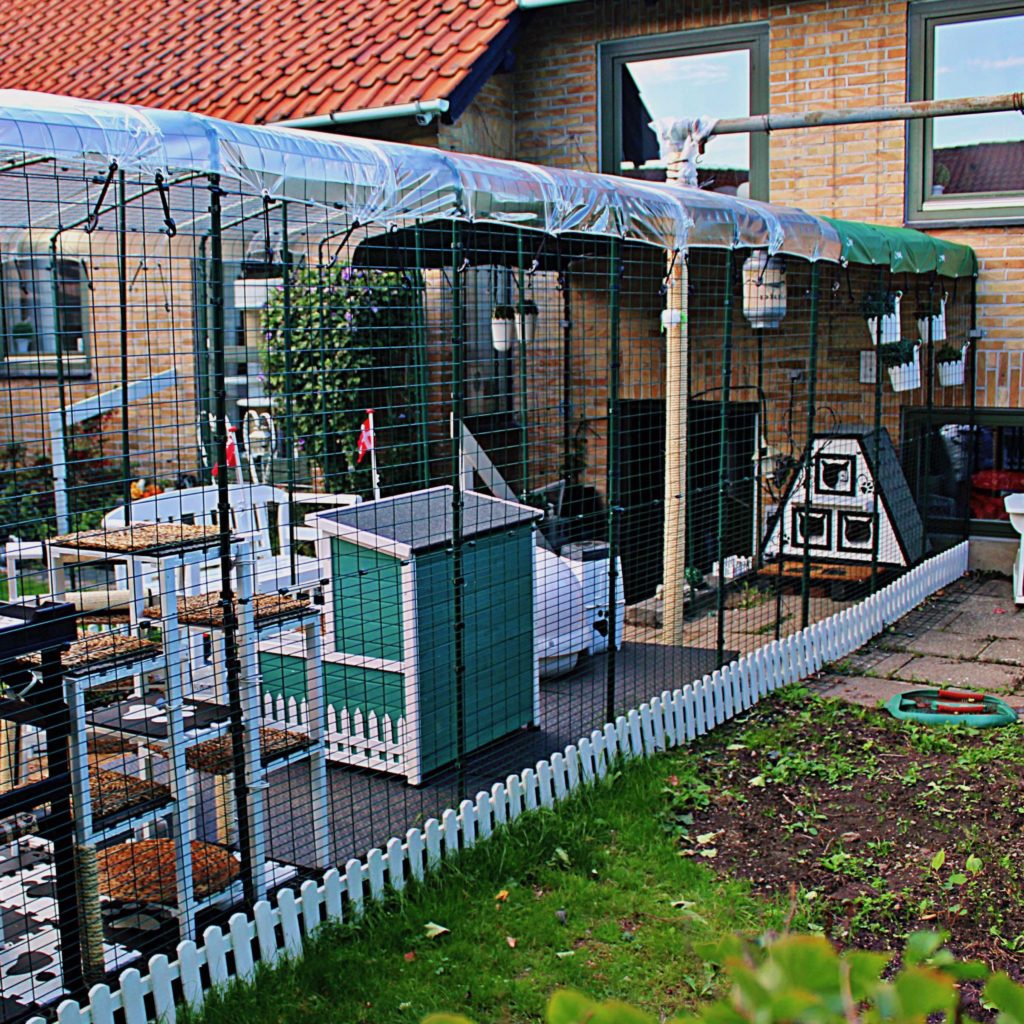
WORK WITH WHAT YOU’VE GOT
This German customer decided to build their run around a small tree in the garden. This way you get around most of the decorating of the run, as the tree will act as both a climbing post, and provide shade during sunny days. Ideal!
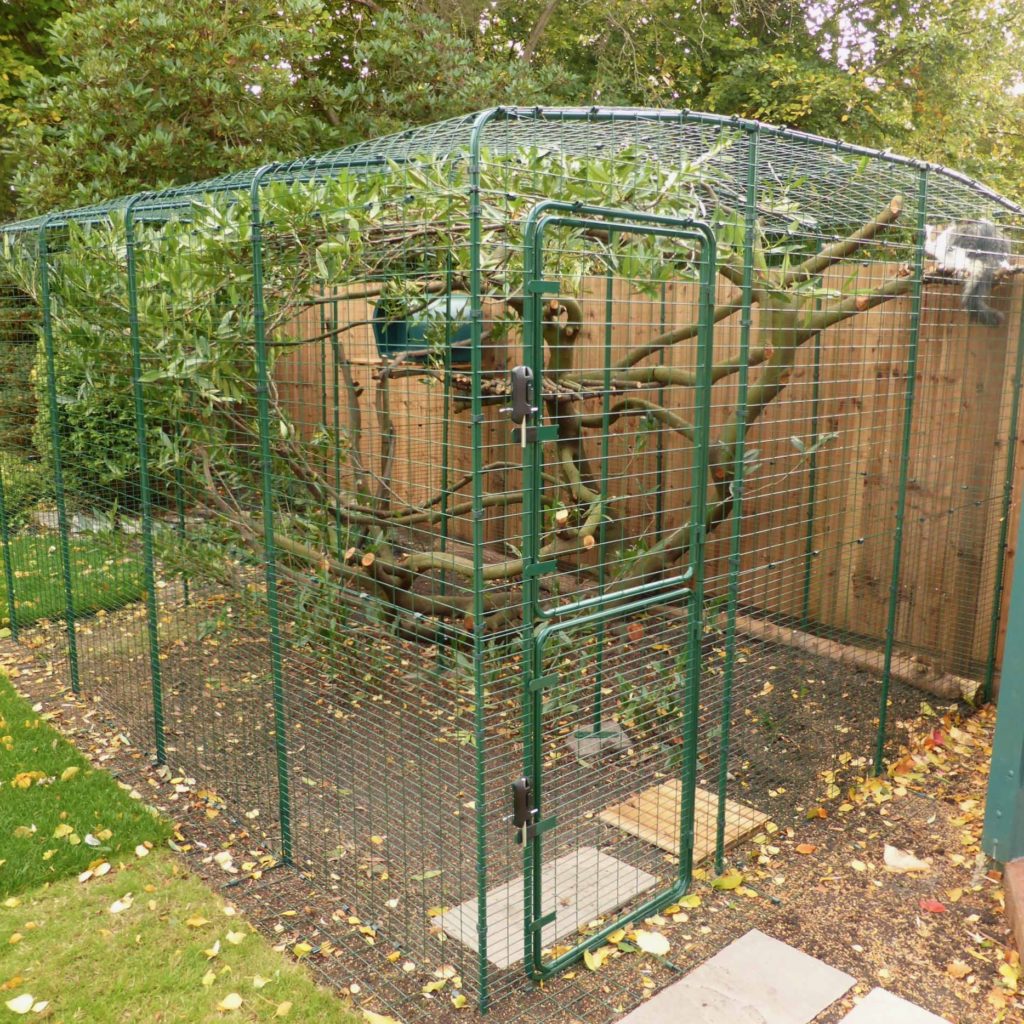
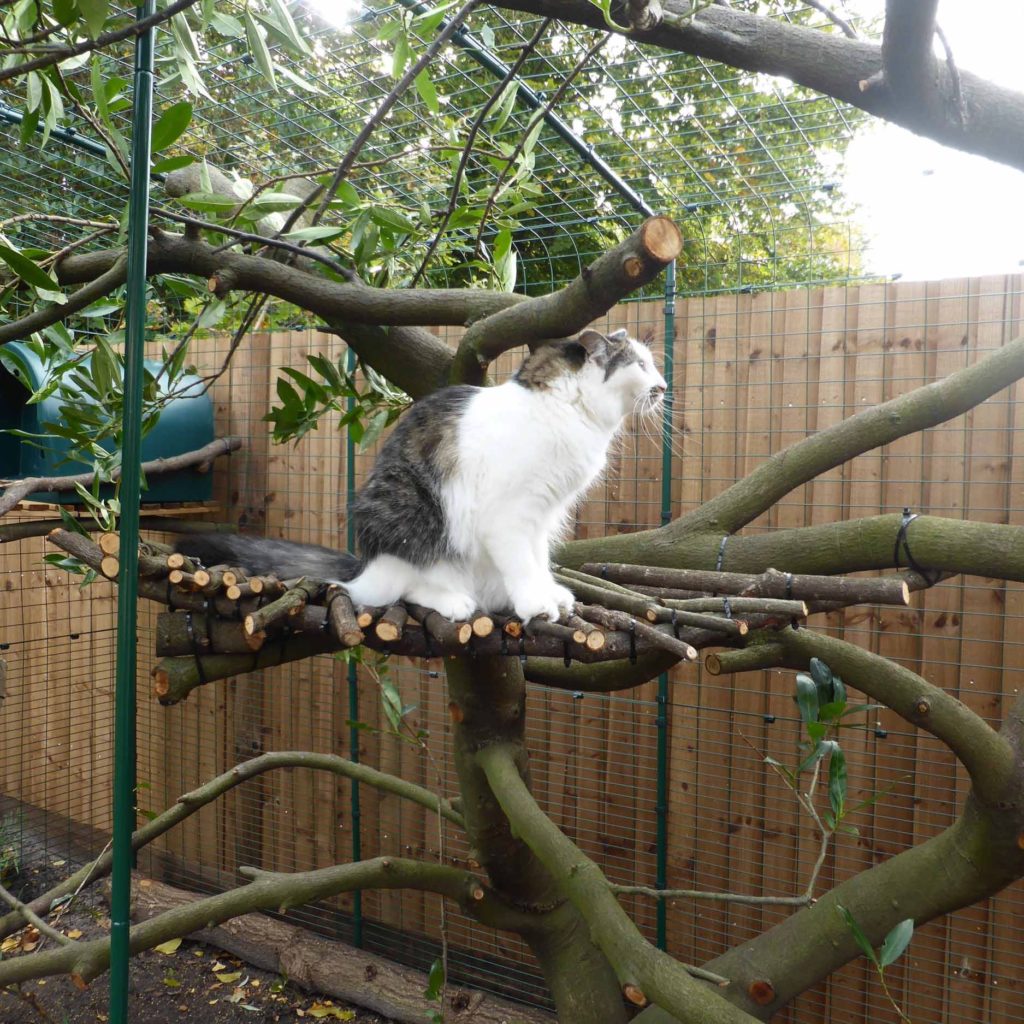

RUN ON WHEELS
The modular design of the cat run does mean that it’s possible to move it whenever needed. If you just want to shift it to a different spot in the garden you can invite some neighbours around and lift the whole run, and if you’re moving house or want to use the space for something else for a while, you can take it down and pack it up into pieces that are easy to store, ready for when it’s next needed.
However, this French customer didn’t think either of these solutions were good enough, and decided to build a platform with wheels, so that the run can be pushed around on the patio to find the perfect sun/shade ratio, or have the cat either relaxing in a corner away from the hustle and bustle, or close to the house for a more sociable time in the fresh air.
Again, a DIY specialist will be able to help you find what you need for this. Our advice would be to make sure you fasten the run on the platform, and that you choose wheels which can be locked to stop the run from rolling into the neighbours’ garden in strong winds!
CORNER SOLUTIONS
If you run out of space in one direction – turn a corner! This amazing feline haven might just be the best thing we’ve ever seen! The different resting places, the play tunnels, the toys, the decorative pebbled outline – who wouldn’t want to spend their days here?

Have you got a cat run? Send us photos of your set up, and you can feature in future posts!
This entry was posted in Cats on January 27th, 2020 by linnearask
While most people check the weather forecast to help them plan their week activities or outfits, chicken keepers can also be using it to predict what accessories their coop needs to ensure their girls are as comfortable as possible.
From sun to snow, wind to wet, the breakfast time weather reports and the handy app on your phone are all giving you helpful hints that you might be ignoring.
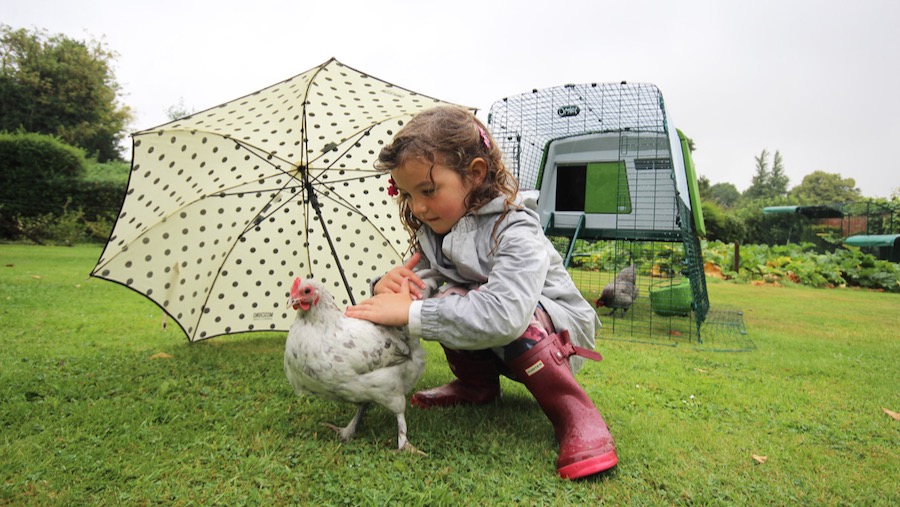
? TEMPERATURE ?
Firstly, the most obvious indicator: the predicted temperature for the coming 10 days. Depending on what time of year we are in, this can be super helpful or utterly confusing if it is varying drastically. But let’s think about what we can act upon.
In winter, if the predicted temperature is at below 32 degrees Fahrenheit for more than 5 days in a row or the temperature is near freezing and you have very few chickens in your coop, you may want to consider attaching the Extreme Temperature Blanket to your Eglu to give your chickens some extra help with keeping warm, without limiting the coop ventilation.
During hot summer months, when temperatures can be above and beyond 85 degrees Fahrenheit daily in some countries, it is wise to move your chicken coop into an area that is in the shade for as much of the day as possible. For your chickens, daily health checks are essential to ensure they are not suffering with the high temperatures. If your coop is attached to or inside a secure run, you can leave your coop door open to increase airflow at nighttime without your girls being exposed to predators.
☀️ SUN ☀️
When the sun is shining, it is tempting to cover your chickens’ run with shades so that it is completely protected from the sun inside. However, this can have the opposite effect on what you intended. Instead of shading and cooling the area, lots of shades create a tunnel which traps the heat, like a greenhouse.
It is best to keep them in a shaded area, and protect one side of the run from the sun. If your chickens are out free ranging most of the day, make sure that they have access to shady patches in the garden, and that their food and water is also in shade.

❄️ SNOW ❄️
Exciting for some, but for others a weather warning for snow can be very disappointing. You may want to consider sheltering your coop’s run with clear covers to prevent as much snow getting on the ground inside the run as possible. If snow is predicted for the foreseeable future, you may want to prepare for long term icy conditions and bring your coop closer to the house so it is easier to check on your chickens, and they can benefit from some of the shelter your house might provide. During the snow, be sure to dry off damp feathers and remove any chunks of ice from claws. Increase the amount of bedding and food you are giving your chickens too as this will help them stay warm.
If you have time, it might be wise to consider how effective your chicken coop will be against the bitter cold. If you have a wooden coop, check if it is water-tight and well insulated. If you are not confident in your wooden coop, consider upgrading to a sturdy plastic alternative, like the Eglu Cube. It’s twin-wall insulation works in the same way as double glazing to keep the cold out of the coop, and the heat in during winter. The plastic material is waterproof and super easy to clean out quickly (especially important on chilly winter days).
☁️ CLOUD ☁️
The most boring of all weather forecasts, but often a rest bite from other more extreme conditions. During winter, a few cloudy days should raise the temperature slightly and give you a good opportunity to clean out your coop and thoroughly check on your chickens and make any changes needed for whatever the forecast predicts for the coming days.
? RAIN ?
Some weather reports are more helpful than others when it comes to the exact timing and chance of there being rain. But if you’re looking at days of 90% chance of heavy showers, it would be wise to act fast and get some protective clear covers over the run. If the ground under your chickens’ coop and run is already extremely muddy and wet, you might want to consider moving them to a new patch of grass, and maybe even laying down a base material, like wood shavings, to prevent it developing into a swamp!
? WIND ?
How you react to a windy forecast completely depends on the wind speeds predicted. Light winds, less than 25 mph, shouldn’t cause much of a problem. You might want to add some windbreaks around the base of your Eglu and a large clear cover down the most exposed side. However, in extreme high winds, the worst thing you can do is completely conceal your run, particularly a larger Walk in Run, with covers from top to bottom. In a large run, the mesh holes allow the wind to flow through without causing any issues to the structure, and a clear cover round one bottom corner of the run will provide chickens enough shelter. If you cover the run completely, the wind will be hammering against it and is more likely to cause the structure to lift or move.
If your chickens are in a smaller run attached to their coop, we recommend moving it to a position where it will be most protected from the wind and any falling debris, for example, against a sturdy building wall. The Eglu’s wheels allow you to easily move the coops around your garden to suit the conditions. If you are keeping your chickens in their Eglu coop and run, and not free ranging during dangerous weather conditions, consider adding some entertaining toys and treat dispenser for them to prevent boredom, such as the Peck Toy or Perch.

This entry was posted in Chickens on January 24th, 2020 by linnearask
Backyard hens spend their entire lives outdoors. This means they have to cope with everything the year throws at them — from blazing summers and sub-zero winters, to year-round downpours. Being hardy birds, they take much of this in stride, but they benefit from a helping hand from their humans. Here are ways to help your flock and prepare for the chicken-keeping challenges in the year ahead.
Winter
Depending on your location, winter can be one of the most challenging seasons for all outdoor animals. While it varies from year to year, the 10 US states that typically receive the most amount of snowfall are:
- Vermont
- Maine
- New Hampshire
- Colorado
- Alaska
- Michigan
- New York
- Massachusetts
- Wyoming
- Wisconsin
No matter where you live, there’s a lot working against both humans and chickens when cold weather sets in – but thankfully chickens are naturally equipped to endure lower temperatures. Because of this, chicken-keeping in the winter isn’t much different from the rest of the year, but a few preparations can go a long way in helping your hens thrive in the cold.
Cold-weather chicken considerations
- Although chickens cope well with the cold, they’ll need some help when it’s both cold and wet. Keeping hens in an insulated Eglu Chicken Coop is a good place to start, with the option to add extra chicken coop weather protection to both the run and the coop. This is especially helpful if you live in an area that receives heavy snowfall.
- Perches in the run enable chickens to cuddle up when it’s cold – which is essential in the winter months. The Omlet Chicken Perch, being composed of eucalyptus, a strong, untreated wood, prevents chickens’ feet from becoming too cold. Offering perches above the frozen ground of the run gives your hens’ toes a break from the chill.
- In sustained sub-zero temperatures, rubbing Vaseline on your hens’ combs and wattles will help prevent them from becoming frostbitten.
- Keep your hens’ feet dry in wet weather by lining the run with wood chippings, straw, or hay.
Winter daylight hours
- Chickens usually return to the coop to roost at dusk. But in the winter, you may find your birds trying to get more time outside on the short days. If your hens are prone to wandering around in the dark, a high visibility hen coat will help you locate them – and also ensure they’re visible to anyone else, should they stray from your yard.
- Installing an automatic chicken coop door with a coop light will help your hens adhere to bedtime. The door can open and close automatically based on the amount of daylight, a specified time, or manually. The coop light will help beckon wandering birds to bed when darkness falls, as chickens will naturally gravitate toward a light source.
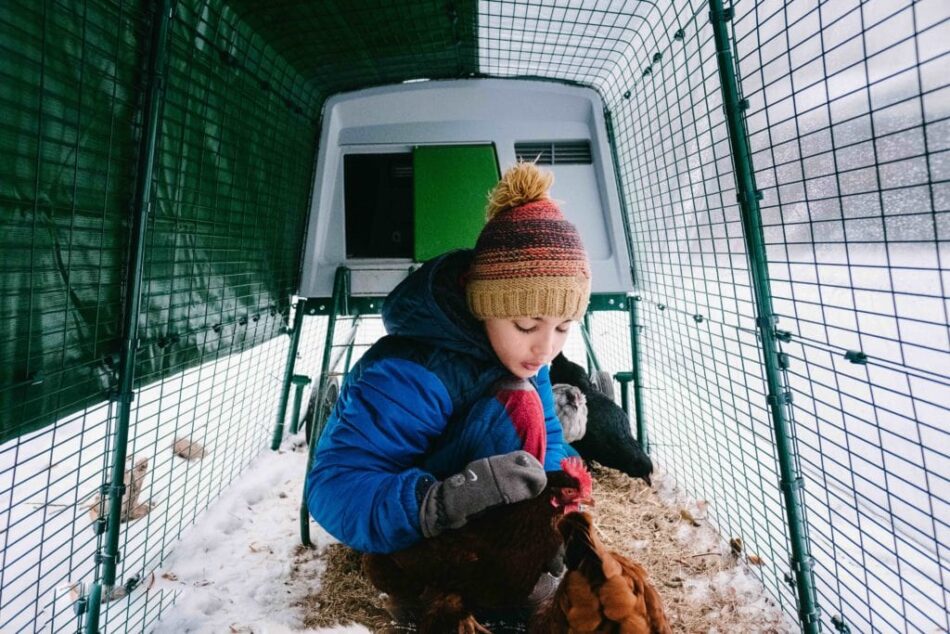
Your chickens’ health during colder months
Keep an eye out for coughing, sneezing, lethargy, or other signs of chicken illness. Older or weaker chickens can become more vulnerable to illness when the cold weather sets in.
- Egg production will decrease – but this doesn’t mean no eggs for breakfast. While your hens may not lay as frequently, and some may stop altogether throughout the colder months, a flock of 4 or more chickens should still provide an adequate supply of eggs for your family during the winter.
- Make sure your hens’ diet consists of high-quality feed and scratch, and consider adding some extra chicken vitamins and minerals to boost their immune systems. Offer hay or greens in a chicken treat holder to provide a nutritional activity on cold days.
- Their water will freeze, so be prepared to break the ice, and have some spare water dispensers ready in case the waterers freeze solid. Pour hot water over any icy water sources throughout the day to help keep things thawed. Consider placing submersible bird bath heaters in your chickens’ waterers to keep them thawed.
- On the upside, winter might kill off any lingering flies, mites, and other pests your chickens encounter during the warmer months.
Spring
As the days lengthen, your hens will start laying more eggs. Vegetation comes back to life, and chickens find insects, plants, and other findings worth scratching around for. Your chickens will likely be wanting to spend more time outside in the warmer temperatures and longer days, but predators also spend more waking hours roaming in the spring.
Protect your chickens from awakening predators
Chicken predators will be on the move when the days warm up and lengthen. In the northern states, large animals such as bears awaken from winter hibernation with a voracious appetite. Other predatory animals such as foxes, wolves, and badgers will also be on the prowl after a lean winter. Central and southern states will see an increase in activity from coyotes, bobcats, racoons, and snakes as the weather warms up.
Keeping your chickens in a secure, covered run is vitally important during early spring when nature’s predators are also taking advantage of the changing seasons. Automatic chicken coop doors will ensure the hens are in and out at the right times, and will prevent predators from gaining access after-hours. The door will also let your chickens out in the morning, so that you can enjoy weekend mornings in bed as the days get longer.
Prepare your chickens for extreme weather events
For southern states, spring can bring extreme weather changes and events such as tornadoes and severe thunderstorms. Housing your hens in a strong chicken coop and heavy-duty, covered run will ensure they stay safe during wild weather. An Eglu Cube chicken coop with added handles and wheels makes it simple to relocate your chickens and their entire home to shelter during severe weather. The Eglu Cube can also be tethered to the ground in preparation for high winds. But just how strong is the Eglu Cube? Some wild-weather events that the Eglu Cube has prevailed against include hurricanes, tornadoes, falling trees from high winds, and more.
Cover walk in chicken runs to protect against hail and heavy rainfall. While tarps will help keep heavy rainfall out of the run, high winds can blow rain in from the sides — and sustained heavy rainfall can create a muddy environment. Add straw to muddy areas of your chickens’ run to help prevent infections such as bumblefoot when the ground is saturated. A chicken tractor is another great option during soggy seasons, as your chickens’ area can be changed daily.
Take proactive steps to reduce chicken coop pests
It’s also important to note that mites and parasites make their debut in the spring, so if you don’t have an easy-to-clean plastic chicken coop, be sure to treat your coops and runs to get ahead of the pests. Mites thrive in wooden surfaces, so housing your hens in a plastic coop is a first line in defense to eliminate pests. Change bedding daily, and clean the interior of your coop frequently to keep your chickens healthy and happy when mites threaten to emerge.
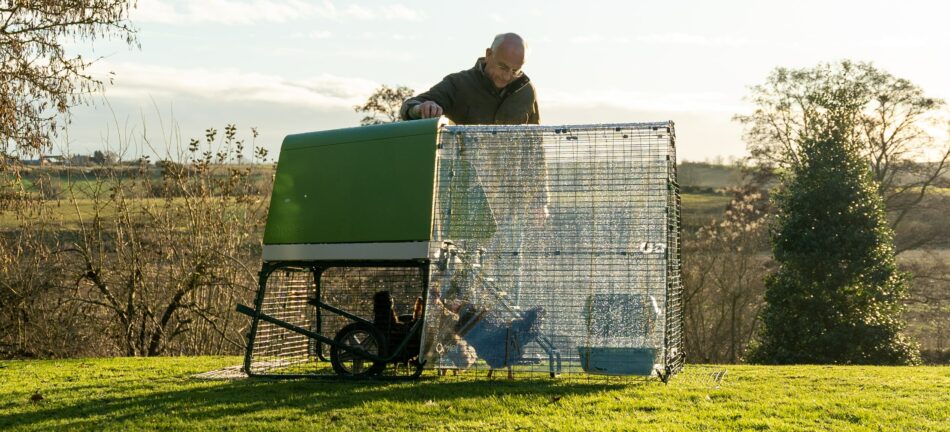
Summer
It’s amazing to see the transformation in your chickens as the seasons change. Gone are the downy, fluffy winter and early spring jackets your hens sported mere months ago. Instead, you may now notice your hens’ feathers slowly becoming more dull, and they are spending more and more time under shaded areas.
For many flock-raisers, summer poses the largest threat to chickens. The main risks that flocks face in the summer months are excessive heat and too much sunlight. Be sure to have plenty of shaded areas where your chickens frequent, and keep fresh, cool water available at all times. A chicken coop that provides shade itself, like the space under the Eglu Cube or the Eglu Go Up, is ideal for the summer months.
On average, these 10 US states experience the hottest summer temperatures:
- Florida
- Hawaii
- Louisiana
- Texas
- Georgia
- Mississippi
- Alabama
- South Carolina
- Arkansas
- Arizona
In these states, special considerations should be made when caring for chickens. Evaporative cooling may help keep flocks cool in drier climates such as Arizona, but chickens living in states that experience heat and humidity have a distinct disadvantage when it comes to options to keep cool.
The Eglu Cube chicken coop is designed to reduce moisture and increase airflow through its ingenious ventilation design. Twin-wall insulation and vents along the back allow for cool air to circulate, while keeping the warm air out. Plastic doesn’t hold onto moisture the way that wood does, so your chickens can find relief from the damp, humid air. The Eglu Cube also offers a shaded area beneath the coop, with the option to add heavy-duty run covers to the sides and top of the run for additional protection from the sun. And, with added handles and wheels, the Eglu Cube can be moved to shadier, cooler spots as summer progresses.
Here are some other methods to alleviate heat-related stress in your flock during the summer months:
- Keep the water supply full, as hens drink more in warm weather. Add ice cubes to waterers if possible throughout the day to keep the water temperature at a refreshing level.
- Provide a dust bath – either a dry area of ground in the yard, or in a container in the chicken run. Cat litter trays, kiddie pools, and even old tires with the rims removed make great basins for dust baths.
- Offer treats like frozen corn or other chicken-safe veggies in a chicken treat dispenser or chicken peck toy.
- Look for any signs of heat stress in your hens. Open-mouth breathing (panting), lethargy, agitation, increased saliva production, or any other concerning symptoms should be reported to your veterinarian. Bring any chicken exhibiting heat stress into an air-conditioned space, but refrain from employing any other cooling measures until hearing from your veterinarian. It can be dangerous for an overheated chicken to have their body temperature brought down too quickly.
Fortunately, the “dog days of summer” usually yield to lower temperatures at night. You may want to offer more space outside of the coop for your chickens to roost overnight in the warmer months, as they will need extra space away from each other’s body heat during this season. A Freestanding Chicken Perch or PoleTree will give your hens aerial space to roost if they need to spread out at night. Just be sure that all of their enclosures are predator-resistant and have a top to prevent aerial attacks. Attaching a tarp to the walk-in run will keep UV rays down, offer protection from summer storms, and also thwart predator attempts from above.
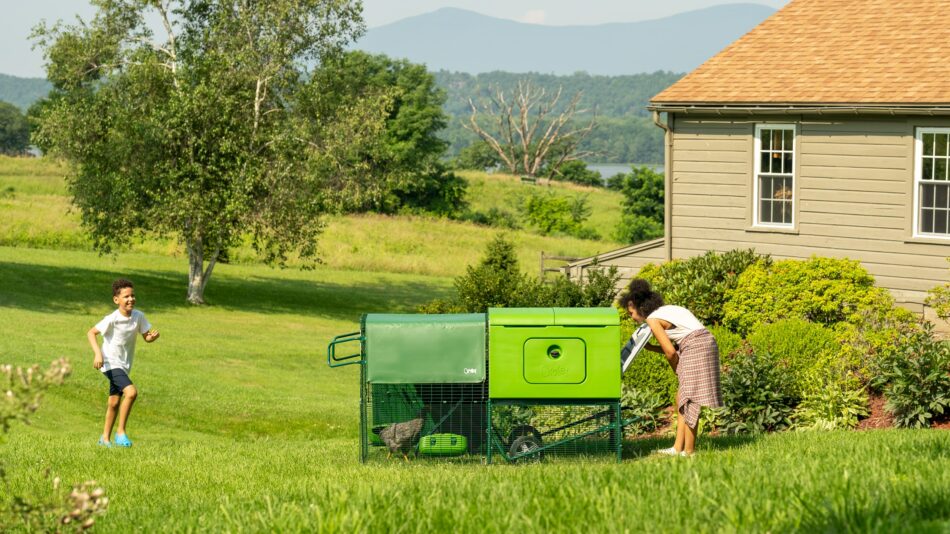
Fall
Fall is a favorite season for both flocks and their keepers. Bugs are still abundant, the temperatures are comfortable, and gardens offer hen-friendly snacking opportunities when gardeners rotate crops.
Hens will often molt this time of year in preparation for colder temperatures, so they need a good diet to help them stay healthy and grow new feathers. Extra vitamins and minerals will boost feather growth, and a little apple cider vinegar in their water will help them grow healthy and glossy plumage. Egg production will cease or drastically reduce while hens are molting, but once they’ve completed their transformation, your hens will resume their laying schedule. The shorter days will prompt chickens to lay less frequently, but good layers will continue to produce eggs during the fall and winter.
It’s important to remember that states along the eastern coast experience the peak of hurricane season during the fall. Be sure to have an evacuation plan that includes your chickens, and prepare for extreme weather. Ensure any chicken enclosures are safe in windy conditions, and cover your chickens’ run to protect against heavy rains.
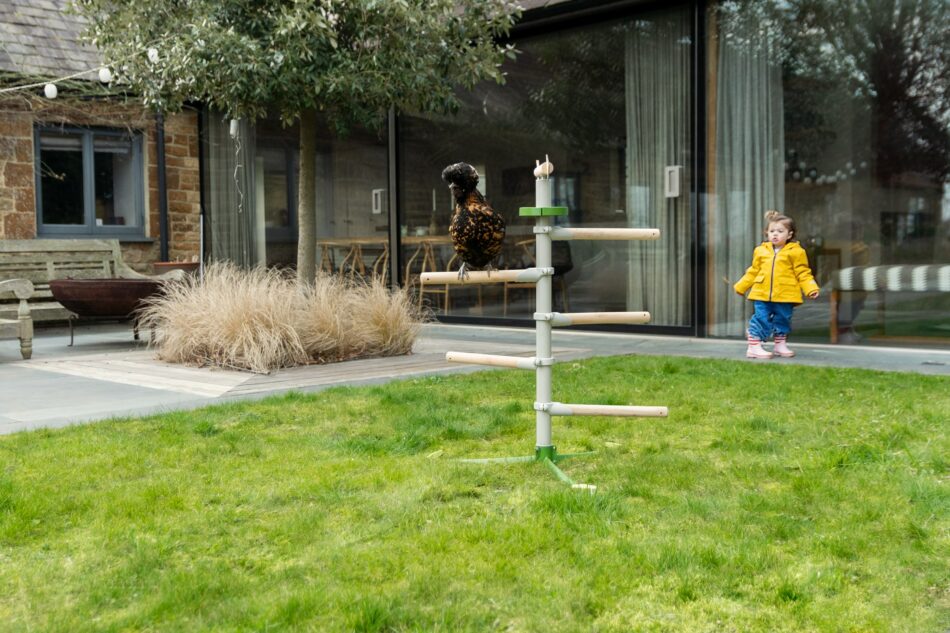
Year-round chicken care with Omlet
At Omlet, we’re here to support chicken keepers all year round. By keeping your hens in an Eglu Chicken Coop and Walk In Chicken Run that are both easy to maintain and clean, you’ll create an environment that is enjoyable for both you and your flock no matter the season. These, along with Walk In Run Covers, make seasonal preparation quick and easy so that the changes in weather, amount of daylight, and looming predators don’t detract from the wondrous connection you’ve created with your chickens. So here’s to another year of chicken-keeping, the Omlet way.
This entry was posted in Chickens on January 17th, 2020 by linnearask

Many people bring their pet rabbits indoors during the winter months. That’s certainly one way of helping them cope with the cold. But is it necessary? After all, wild rabbits survive the winter without having to ask us to turn up the central heating.
However, wild rabbits have a very important trick up their furry sleeves. They live in burrows, protected from the weather in the confines of a cozy rabbit warren. Pet rabbits don’t have access to this comfortable underground lifestyle, so you’ll need to simulate it in other ways.
The key to underground living is insulation. In the same way as an igloo creates a relatively warm space in a cold environment, a burrow provides an insulated living space with a constant temperature. Not exactly a hot spot, but somewhere that can be warmed up by lots of furry bodies, dry grass and compacted earth.
Hutch insulation can be reinforced by adding extra bedding materials. The paper lining commonly used at the base of rabbit bedding soaks up urine, and so it gets wet very quickly. Anything wet can soon become cold, and can even freeze if the temperature really plummets. In really cold weather – anything below zero degrees C – change the paper lining daily.
The real key to cold weather comfort is hay. Double, or even triple the amount you normally use in the rabbits’ sleeping area, and they’ll be snug through the night.
Not all hutches are equal
An old wooden hutch with gaps and cracks for the cold wind to blow through is always going to be a lot less cozy than something more windproof. The ideal hutch has all-round insulation, like the Eglu. This will still need its thick mattress of hay, though.
There comes a point when cold weather is actually dangerous. If temperatures plunge below minus 5 C, wild rabbits hunker down and lie close together to share and conserve body warmth. In a garden hutch they will struggle when things get this cold. Not many pet rabbits can cope with sustained temperatures below minus 5, even in something as well-insulated as an Eglu.
In these extreme temperatures, there are two choices: bring the bunnies indoors, or use a heat pad in the hutch.
It will also help, of course, to keep the hutch in a sheltered spot, away from the worst of the winter winds.
How to fight the freeze
Rabbit water bottles freeze when the temperature falls. You can help prevent this by wrapping insulating material – bubble wrap is good – around the bottle. The water bottle in the Eglu, for example, comes ready-insulated from the cold. But even this will freeze when it gets really cold. You’ll also need to make sure the water bottle nozzle stays unfrozen, which involves changing the water bottles a few times each day. Always have a couple of spares, for this purpose.
The hutch itself can be made cosier by adding insulation to the outside. Extreme temperature jackets are a much better option than a thick blanket, as the latter will get wet and then freeze.
If the weather forces you to bring the bunnies indoors, keep them there until things warm up again. It’s not good for their health if they are forever going back and forth from cold winter to centrally heated house or shed.
Eating to keep out the cold
Outdoor rabbits, like all small mammals subject to the whims of the seasons, have to eat more during the winter. This enables them to stoke their internal central heating. We humans tend to forget that the food we eat is largely fuel to heat us up from the inside out – part of being a warm-blooded mammal rather than a cold-blooded fish or reptile.
A cold rabbit will shiver. If, in spite of your insulating efforts, you notice a whole lot of shaking going on in the hutch, you need to take action. Heating pads, or the great indoors – those are the options.
It’s important to remember, though, that rabbits love having access to fresh air. They are hardy creatures, and you don’t need to keep them cooped up until the spring. As soon as the cold snap passes they can move to their outdoor quarters again.
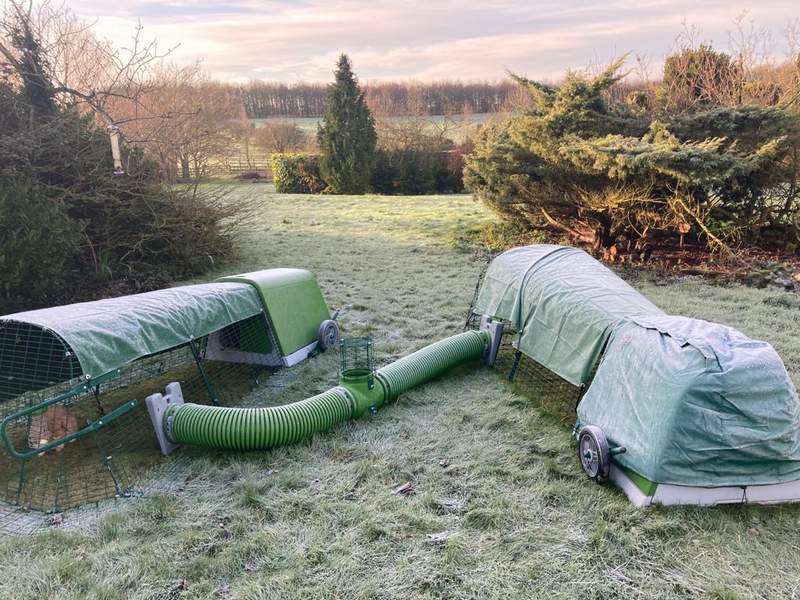
This entry was posted in Rabbits on January 14th, 2020 by chloewelch
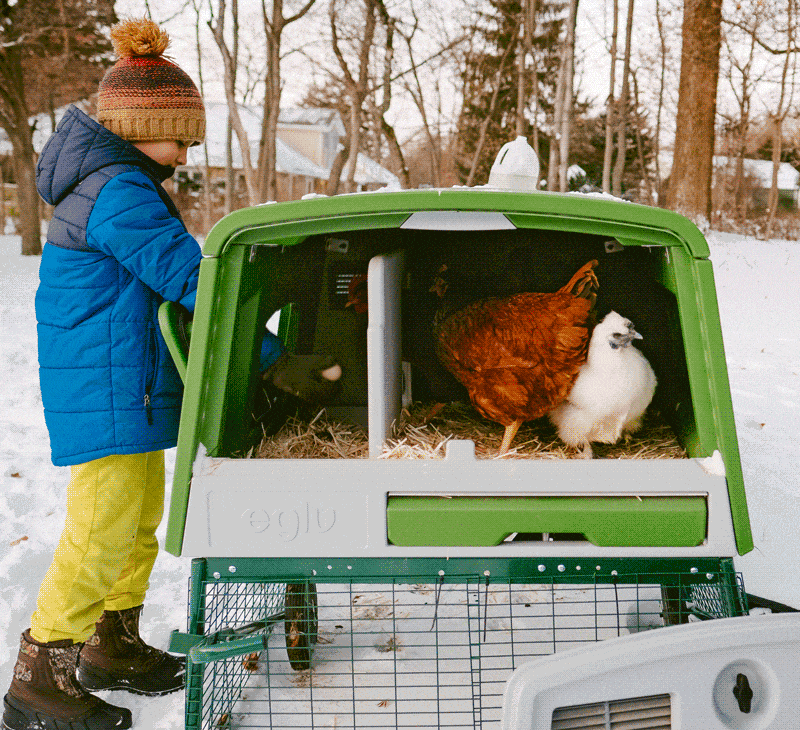
During the winter, one of the biggest concerns among chicken keepers that have purchased, or are considering, an Eglu is how well it can keep their flock warm. In this blog, we will dive into the science behind the Eglu’s thoughtful design, with particular emphasis on how these features will help your chickens stay warm during the colder months.
Insulation
Insulation prevents energy from passing through it, and air is an excellent insulator! Think of your chickens in the cold – they fluff up their feathers in order to trap more air between their layers of feathers. Pretty amazing, right? By doing this, they create their very own insulation. Air is such a great insulator because it has very little conductivity, which is the ability to transfer heat. Air molecules are spread out, so even though warm, fast moving molecules are bouncing around within the air, they only lose heat when they come into contact with slower moving molecules to pass warmth off to – which in turns causes the temperature to cool. In short: air doesn’t have as many molecules for heat to pass its warmth off to, thereby keeping an area warmer for longer. Air is used to insulate many commonly encountered objects and structures – from your favorite puffer coat, to your thermos and even the walls of your home.
Just like the walls of your home, the Eglu’s unique twin-wall design captures air in between the layers, creating a “pocket” of insulation to surround the coop. Not only does this method prevent cool air from moving in, but it also keeps the body heat your chickens generate inside. On the flip side, the same method helps to keep heat out of the coop during warm weather.
Ventilation
Ventilation is any coop’s best friend – but it’s a delicate balance between how much airflow is needed. Too much airflow creates chilly drafts, and too little airflow causes moisture to build up inside the coop which can lead to multiple health issues for your hens.
Eglu coops are designed to allow air to flow through the coop through well positioned vents. This draft-free system ensures that clean air is able to circulate through the coop while still keeping your chickens warm. The moisture created by your chickens will be circulated out through the same process, preventing moisture buildup.
How chickens keep themselves warm
As mentioned, chickens have a built-in mechanism for creating their own insulated barrier from the cold. You’ll notice your chickens “molt” (shed their feathers) in preparation for the winter. While it may look alarming, your half-naked chickens will regrow thicker, more dense feathers for the winter. These dense feathers are used in their “puffing up” technique to help hold the longer feathers on top away from their skin. The thickness of their downy feathers underneath traps the air that their visible plumage is allowing in. The result is a fluffed up, warm (and adorable!) hen.
Chickens will also ramp-up their already fast metabolisms in the winter to help generate heat. Be sure to offer them extra feed during this time to support this metabolic shift! Feeding extra scratch grains or alfalfa hay in the evenings will help keep their body heat up on chilly winter nights.
As a cold-defense mechanism, blood flow will be redirected from your chickens’ legs and to their bodies in an effort to keep them warm. Their feather-less legs have scale-like coverings that trap some heat in, but often you’ll see your chickens warming up their chilly legs. Some hens will alternate standing on one leg in a flamingo pose to warm one leg up against their body. The hen will switch legs to repeat the process on the other side once one leg has been sufficiently warmed. You’ll also notice that chickens will drape their feathery skirts over their toes when they roost to warm them up! By giving them chicken perches or chicken trees in their run, they’ll have multiple opportunities to warm their toes after walking on the frozen ground.
The Eglu isn’t made of ice, but it can withstand it
Our Eglu coops might not be made of ice, but they’ve been created to withstand the elements! For particularly cold areas, extreme temperature jackets can be added for extra-insulation. And since you’re now a pro at understanding how air is a great insulator, you can see why adding another layer to trap even more air around your chicken coop will help keep more heat in and more cold out!
Inventing and engineering minds are always hard at work at Omlet, and the Eglu chicken coop is just one of many pet products designed with practical science to benefit both the animals and the people that love them! You can rest easy this winter knowing that your chickens will be nice and warm all season long in their Eglu coop.
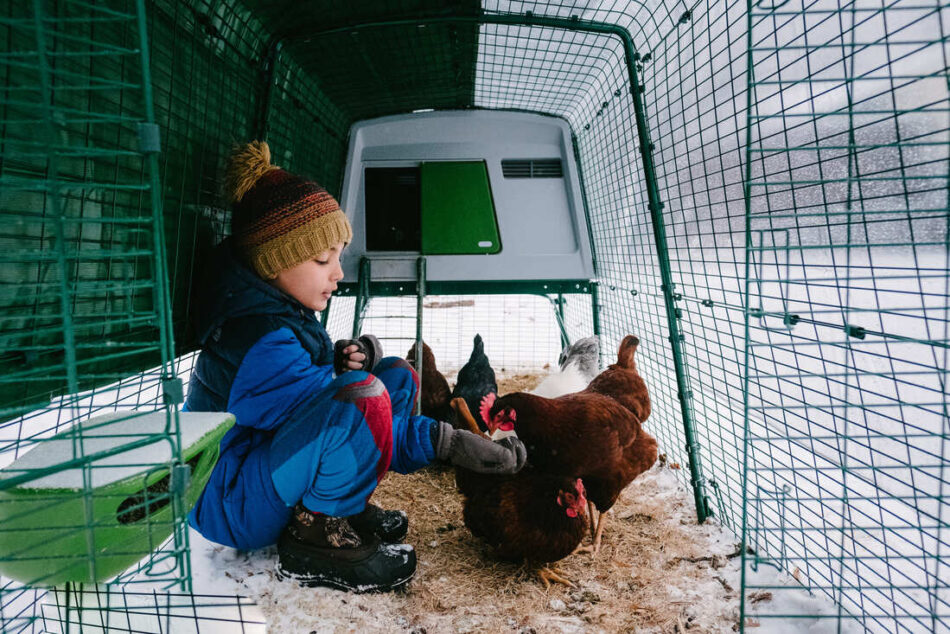
This entry was posted in Chickens on January 10th, 2020 by linnearask
…make it this one.
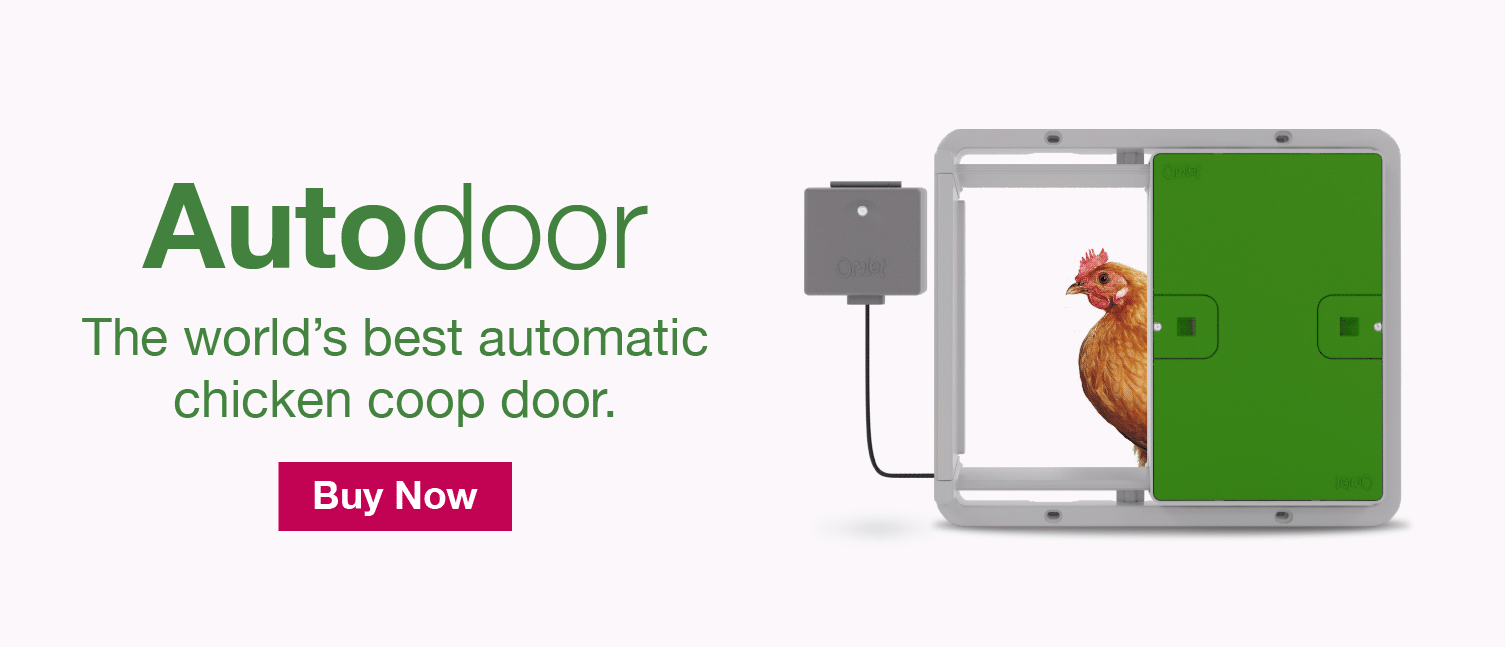
From the latest smartphone to super clever hairdryers, we often hear and read about the top new gadgets that we need in our lives, and more recently we are beginning to see amazing tech products for our pets! But what about chickens? Yep, even our feathered friends are getting a look into the future, and this is not something to be missed.
If you buy one thing for yourself or your chickens this week, make it this.
The Autodoor.
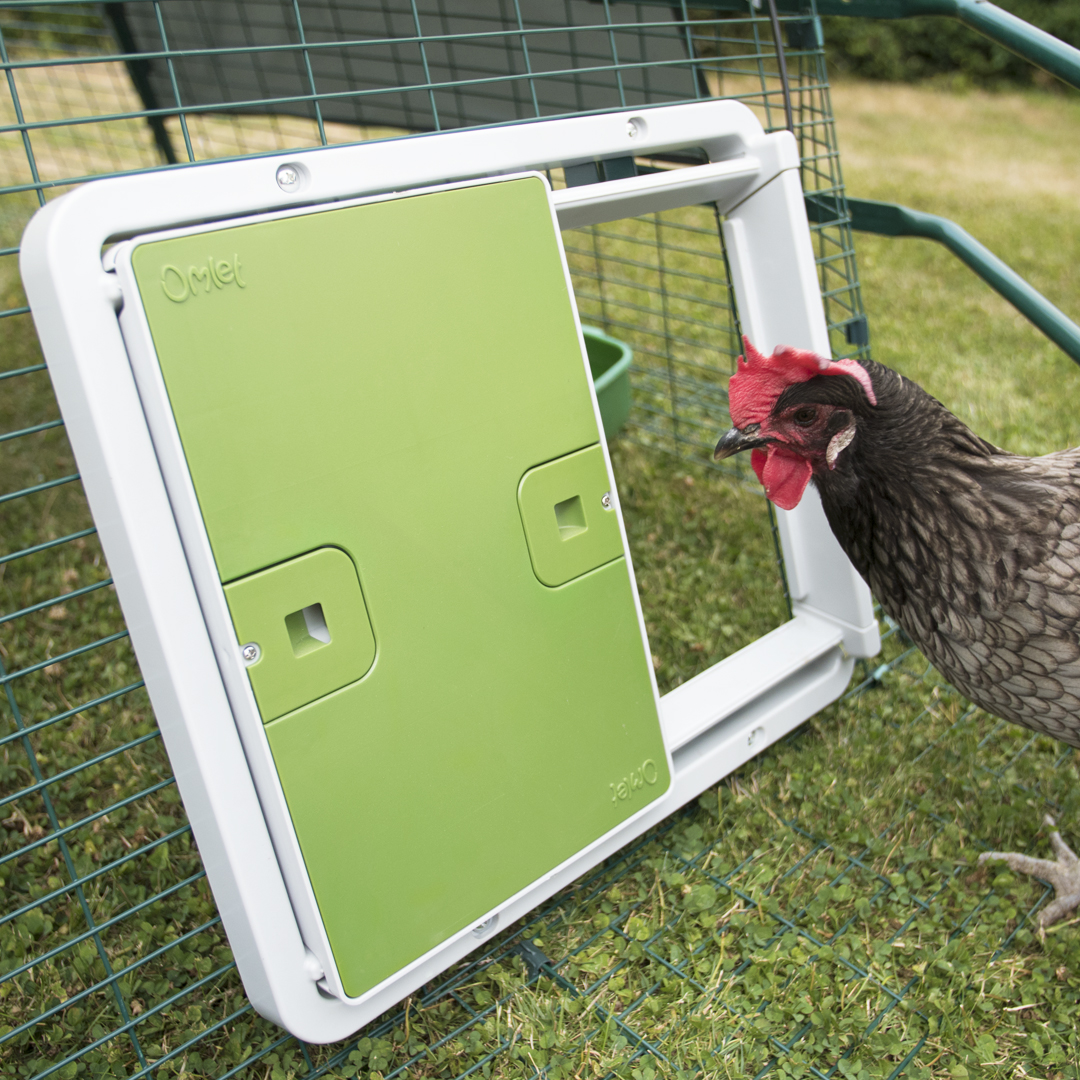
This one simple addition to your chickens’ coop, can make a hugely significant difference to your life as a chicken keeper, and many users swear by it.
Secure the Autodoor to your chickens’ enclosure; this can be the Eglu Cube house, Eglu run, any wooden chicken coop or chicken wire, and use the control panel to set when the door opens and closes, based on a specific time or a percentage of light.
In the morning, the Autodoor will open with no fuss, allowing your chickens out of their coop or run to explore, graze and stretch their wings, especially useful in summer, when your chickens are wanting to get going far earlier than you. There’s no need to get up at 5am when you have an Autodoor.
In the evening, as the sun sets, the Autodoor can be programmed to close at a time when you know all your chickens will have gone into their coop to roost, so they can be secured and safe from predators. In winter, when it can be dark before you get home, you won’t have to worry about having to hurry back in time to shut them in. The Autodoor can do it for you.
Here’s 5 other reasons, you need the Autodoor…
- Battery-powered. No need to keep your coop close to a power source.
- Reliable in all weather conditions. This is a gadget that will take you from winter to summer, and back again.
- Built in safety sensors ensure no chicken is harmed when investigating their new gadget.
- Improves coop security and insulation. The horizontal door is far safer than it’s vertical, guillotine style competitors which can be easily lifted by predators.
- …and finally, the Autodoor is now 25% OFF when you sign up to the Omlet newsletter here. That’s a huge saving of $47.25! Find out more and get your unique discount code here.

This entry was posted in Chickens on January 8th, 2020 by chloewelch
Is “become an Omlet superfan” in your new year resolutions? We don’t blame you! Here’s all the super easy ways you can keep up with our special offers, competitions, videos, blogs and more in 2020!
Newsletter

Our weekly newsletter is jam packed with fun articles, information about exciting new launches and promotions, and reviews from customers. By subscribing to the newsletter, you will make sure that you’re the first one to know about everything Omlet! We also regularly deliver exclusive offers just for newsletter subscribers which we promise you will want to hear about. We can’t say too much, but it is very likely there will be an amazing Eglu offer coming up at the end of January ?
Youtube

The Omlet Youtube channel is a great place to explore our products. The informative and fun videos show all the groundbreaking features that customers love, with the added bonus of some very cute animals! By subscribing you will always be fully clued up on the latest Omlet innovations, and you will find plenty of useful information about keeping pets, like this one about making your Eglu ready for winter.
We also have helpful step-by-step videos showing you how to build all our products, resulting in fewer arguments and less frustration! You can have them playing in the background as you put together your pets’ new home, and it’s easy to pause or go back if needed.
Facebook Groups

The Omlet Chicken Keeping Facebook Group is a great place to meet other Eglu lovers. Our friendly customers share tips and tricks on keeping chickens, discuss the features of products and tell stories about their pets. Whether you’re a veteran crazy chicken lover or a total beginner, you’ll enjoy being part of Omlet’s Chicken Keeping Community!
Social Media

Integrate Omlet into your favourite social media feed and brighten up your scrolling time with cute pet pics, awesome new products, amazing competitions, promotions and much more! You will also get all the information you need to take part in the many competitions we will be running in 2020. You won’t want to miss out, so make sure you follow us today!
This entry was posted in Pets on January 7th, 2020 by linnearask

1. Don’t shut your chickens in their coop
Chickens are built to be outside, and they are known to withstand some pretty extreme temperatures. Under the visible plumage birds like chickens have a layer of downy feathers that can be puffed up to create an extra layer of insulation that will keep them warm.
Cooped up chickens will soon get bored and agitated, and even though you might be surprised that they choose to go out in freezing temperatures, you should definitely always give your chickens the opportunity to stretch their legs.
Ensure chickens have a dry and sheltered spot in a secure run or in an area of the garden where they can spend time outside. We have plenty of different covers that makes this an easy job. Clear covers are ideal for winter as they will protect your chickens from wind and rain while still letting the light in. Put straw on the ground to prevent a build-up of mud and install a perch or two for the chickens to rest on during the day.
Close the door to the coop when all chickens have gone inside to roost for the night or let your Automatic Chicken Coop Door do it for you.
2. Don’t compensate for bad insulation by blocking up the coop
Well insulated coops, like the Eglus, will keep the chickens warm in winter by capturing the heat from the chickens’ bodies while not letting any cold air travel through the walls. They are also designed to let air flow through the coop to prevent a buildup of moisture, without any nasty drafts.
Drafts and moisture are the two biggest winter enemies for chickens, as they make it difficult for them to stay warm and dry. If the coop is too tightly insulated the moisture evaporating from the chickens’ breaths and droppings will have nowhere to go. This humid environment – and the possible buildup of ammonia – is really bad for chickens and can lead to unpleasant respiratory illnesses.
Make sure that your coop is well ventilated, with vents that directs the air somewhere other than straight onto your chickens.
3. Don’t heat the coop
Chickens are hardy creatures that will gradually adapt to lower temperatures and heating the coop will mean that your chickens never get used to the cold. This will also make them less likely to actually leave the coop and get that exercise, fresh air and entertainment that they require to stay happy and healthy.
Apart from the fact that heaters in the coop will always be a potential fire hazard, you also run the risk of your ill-adapted chickens getting a shock at a sudden drop in temperature if the power was to go off for some reason. This is much worse for them than having a slightly chillier coop.
If you’re worried you can always add a bit of extra bedding to the nest box or put an extreme temperature cover on your Eglu.
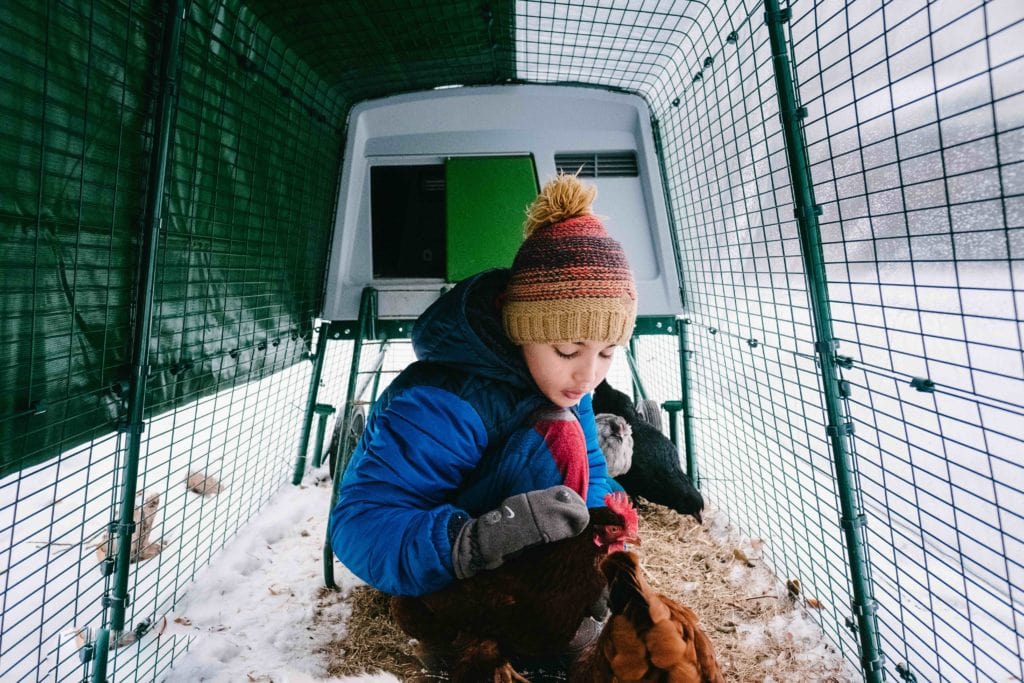
4. Don’t leave eggs too long
Although the Eglu will keep your eggs warm and toasty, there is a risk that eggs laid elsewhere in the run or the garden will freeze in winter. Frozen eggs are not automatically dangerous to eat, but when the content of the egg freezes and expands, there’s a higher risk of bacteria entering through the cracks in the shell.
Collect the eggs every time you visit your chickens to minimize the risk of a frozen yolk.
5. Don’t ignore the water
As goes for all animals, you will want to give your chickens constant access to fresh water, even in winter. They won’t drink as much during the colder months, but here that’s actually a disadvantage, as the water is more likely to freeze if not touched regularly.
Bring the drinker inside overnight and take it out when you go to check on your girls in the morning. If the temperature goes below zero during the day, check the water as often as you can, and break the ice or change the water if it has frozen.
There are several water heating solutions available on the market. There are heaters that you can easily plug into an outdoor power source, but there are also battery powered heaters you can put in the water. Just make sure the chickens are not able to peck their way through the heater.
If the temperature stays around zero, you can put something floating in the water, like a tennis ball. As the floating object moves, it will break up surface ice as it forms on the water, which will stop, or at least slow down the freezing process.
6. Don’t put off cleaning the coop
Hanging out in the garden is not as tempting in winter, but you will still need to make sure the chickens’ house is nice and clean. It is likely that your chickens will spend more time in the coop in winter and produce more droppings there, so keep an eye out and change your routine accordingly.
7. Don’t limit the fun
The chickens might not venture as far out in the garden as they normally do, and the opportunity to forage for bugs and other treats will be limited when the ground is frozen or covered with snow. This can lead to chickens getting bored, which might result in aggressive feather pecking and egg eating.
You will need to make sure that they have plenty of fun things to do in their run. We have lots of boredom busting accessories in our shop. Put up perches the chickens can sit on and try the super fun Peck Toys or the Caddi treat holder for gradual treat-dispensing hentertainment. Or, if you feel your chickens might be the adventurous kind, why not put up a Chicken Swing they can enjoy together?
8. Don’t stick to the same feeding schedule
Your chickens will most likely eat more in winter, as they need the energy to keep warm. Give them some extra food, and make sure it doesn’t freeze in the feeder. For an extra snack, sprinkle some corn on the run in the afternoon to add both calories and some foraging fun. Or why not try this yummy chicken porridge that will warm their tummies on cold winter mornings.
Also make sure that you provide plenty of grit. As chickens don’t have teeth they need it do digest their food. The rest of the year they find and swallows little stones and pebbles as they peck around the garden, but if the ground is frozen this will be much harder.
9. Don’t ignore combs and wattles
All chickens, but particularly breeds with large combs and wattles, run the risk of frostbite on these sensitive body parts during winter. It’s not necessarily dangerous as it’s normally just the tips that get affected, but can be a bit uncomfortable. To prevent this, apply petroleum jelly to the combs and wattles during cold spells.
10. Don’t take covers off when the sun is shining
If you’re in the habit of taking the covers off the chickens’ run when it’s sunny, it might be a good idea to stop doing this in winter. Clear covers in particular will create a lovely sunroom feeling on the run when the sun is out, and your girls will love having a warmer spot to retreat to. Covers will also stop cold winds, so we would suggest keeping them on permanently in winter.

This entry was posted in Chickens on January 7th, 2020 by linnearask


































